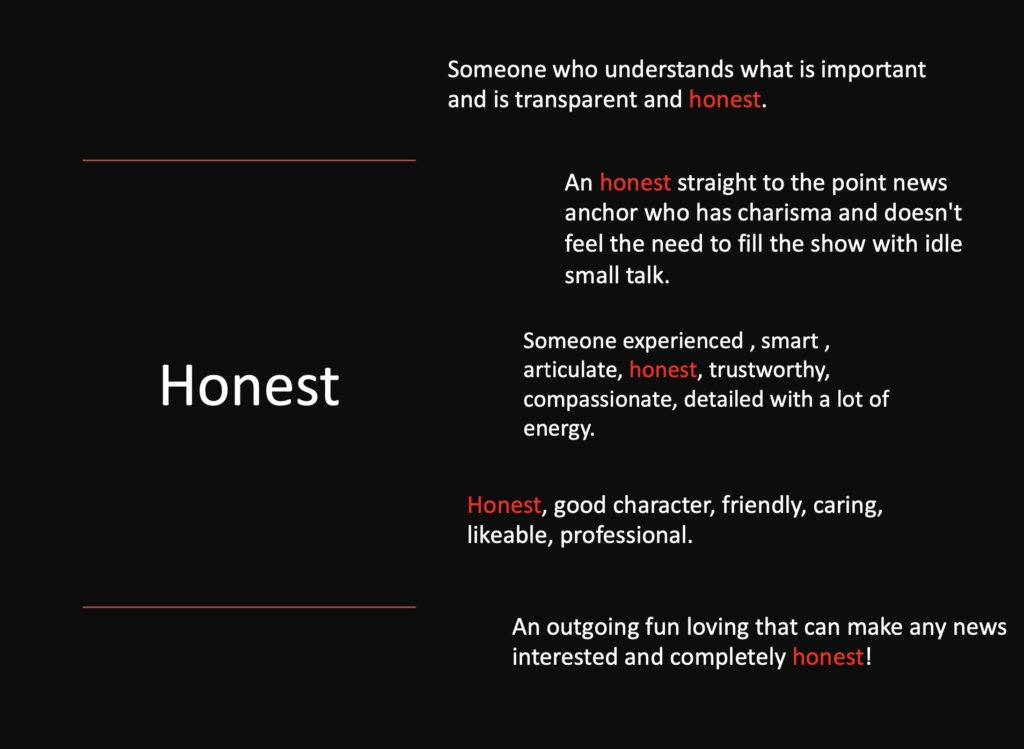
A few years ago, I came across an article detailing how companies like BMW and Sheraton were using text analytics and computer technology to analyze customer comments. In the time it took to click “Submit,” the programs were telling them not just what customers cared about, but what they cared about most – and with depth and specificity impossible to achieve using simple word clouds and manual review. Their customer service and marketing teams said they were understanding how to please and reach their customers like never before.
We struggle with the same limitations in television news, of course – in particular, when it comes to understanding what people value in on-air talent. Quantitative studies necessarily limit the range of response – and what we can learn from them – to a list of predetermined values. There’s no way of knowing what might be important that’s not on the list. Qualitative focus groups offer a chance for more open-ended discussion, but samples are relatively small and group dynamics inevitably impact the result.
The approach these folks were taking overcame these limitations. Questions could be open-ended and customers could respond in whatever way they wanted, in the privacy of their own homes. And they could talk to lots of customers. In effect, they were getting qualitative insights on a quantitative scale.
I wondered whether these technologies could be used to research television news talent. Turns out they can, and it means we’re understanding what viewers value – and how it’s changing – like never before.
Researching TV News Viewers: In Their Own Words
Over the past several years, we’ve used advanced text analysis and analytics (Natural Language Processing and Quantitative Text Analysis, to be fancy about it) to deep-dive on thousands of viewer verbatims related to television news and news talent.
In our projects, there are no lists of predetermined attributes to rank or value. There are no limits on how viewers can respond (“In five words or less…”) or how much information they share or how they share it. People can say whatever they want and as much as they want.
This means we get tons of qualitative data that our machines and technologies evaluate with a quantitative reliability that’s impossible to achieve manually or by studying a simple word cloud.
Mapping viewers’ language gives us a way into their minds we just haven’t had before. We don’t just learn what people value. We learn what people value most. And we learn how people link – and language – what they value..
And what people value can change.
One long-standing assumption our findings are challenging is the idea that what viewers value and want from news talent is relatively static. As you’ll see, viewer expectations change – at times, dramatically – as the emotional needs of the community change.
Tracking What Viewers Value in News Anchors
2019: Living on Easy Street
In 2019, a time in America when life for most was relatively stable and predictable, we asked viewers what attributes would make them want to watch a news anchor on a regular basis. Here are the qualities cited most:
- 1. Personality
- 2. Funny
- 3. Honest
- 4. Voice
- 5. Personable
- 6. Professional
- 7. Friendly
- 8. Relatable
- 9. Humor
- 10. Relatable
- 11. Intelligent

This was consistent with feedback we’d had in 2018, another year of relative stability for most viewers. When we asked what kind of anchor they’d love and want to watch on a regular basis, Personality topped the list. And the ability to be funny was not far behind. (We’ll address what viewers mean by Funny in a future post. It’s not as simple as it sounds!)
2020: Living with Fear and Panic
In 2020, of course, the world changed dramatically and abruptly. When we were in the field talking to viewers in May, Covid-19 had disrupted American life in unimaginable ways. People didn’t know when, how, or if they would work again. Schools were closed. Race-related tensions were increasing and Black Lives Matter protests were prominent in many cities across the country. The news of the day had become more personal to almost everyone.
This time, when we asked what viewers valued most in television anchor talent, what they told us had changed, too.
- 1. Community
- 2. Personality
- 3. Funny
- 4. Honest
- 5. Humor
- 6. Area
- 7. Professional
- 8. Real
- 9. Friendly
- 10. Intelligent
- 11. Knowledgeable

Community had not even been on the list of attributes cited by viewers in prior years. Suddenly, it was at the very top. And while knowing the community was undeniably a part of the equation, what viewers clearly valued most were talent who cared about the community. With the stakes in their world so high, viewers wanted talent who were emotionally vested in the outcomes.
Late 2020: The Return of Hope and Promise (Briefly)
In late 2020, the state of communal anxiety seemed to be lessening. The election was history, vaccines were coming online, and there was a pervasive sense that the world was working its way back to something like normal. We wondered whether that sense of communal relief would shift expectations of anchors once more.
Again we saw viewer preferences respond dynamically to communal shifts in attitude and emotion. While “Honest” had always been on the list, it had never been so high. And if we combined references to “Honest” with references to “Trust” and “Trustworthiness,” the total would easily have topped the list.
- 1. Personality
- 2. Honest
- 3. Voice
- 4. Professional
- 5. Community
- 6. Funny
- 7. Friendly
- 8. Humor
- 9. Area
- 10. Nice
- 11. Serious

For us, there’s something important and comforting in the idea that your relationship with the community is emotionally dynamic. Viewers value talent — and organizations — that know and understand what they are going through and how it makes them feel. As the world around them changes, what viewers value about your work and your team changes, too.
That said, there is a critical warning inherent in all of this. The focus on honesty is more proof that the crisis in confidence about what journalists do and represent is real. For many, the idea that you are fundamentally honest and trustworthy has been overwhelmed by the assumption that you’re not. Your intentions are suspect and you’re producing “fake news.”
If the best defense is a good offense, it’s never been more important to show up on-air in ways that will earn trust and leave people wanting more from you.
In an upcoming post, we’ll talk specifically about how delivery can help your team do that.
Our coaching is research-driven.
Also:
We’re currently in the field testing what viewers value in weathercasters. And this Fall, we’ll be going back into the field to learn more about what viewers value in anchors — and to understand how it continues to change. If you’d like a copy of our reports on this, just fill out the form at the bottom of this page and let us know you’ll be happy to hear more from us. We’d love to share it with you.



